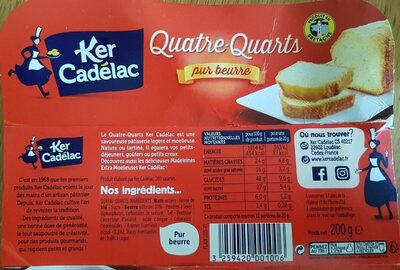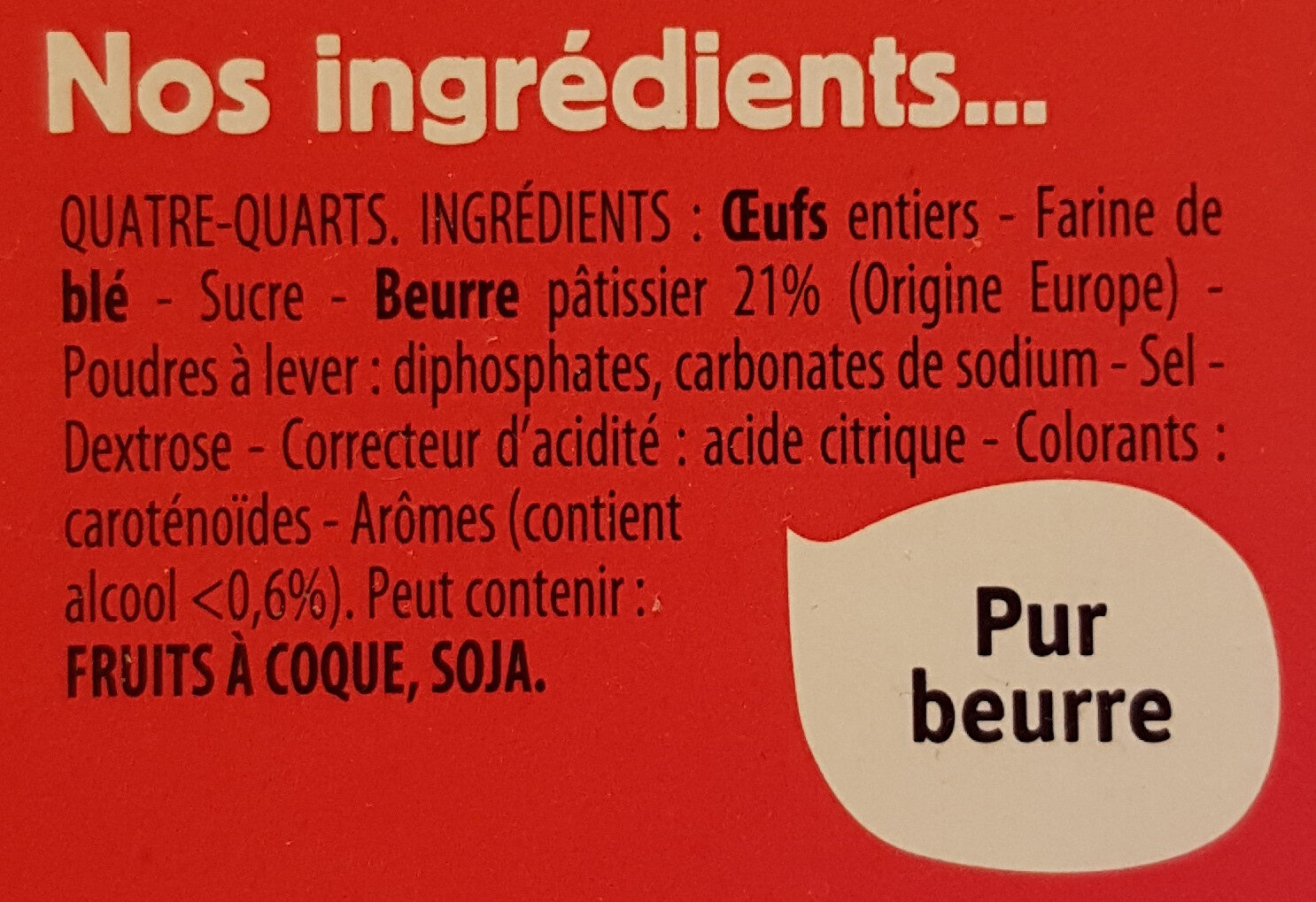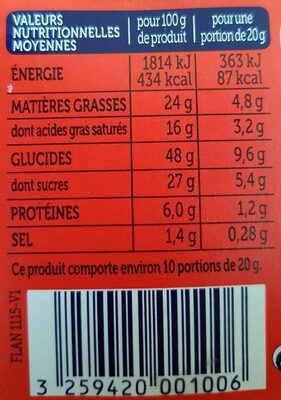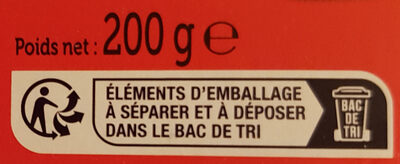Help us make food transparency the norm!
As a non-profit organization, we depend on your donations to continue informing consumers around the world about what they eat.
The food revolution starts with you!
Ker Cadélac - Quatre Quarts Cake, 200g (7.1oz) - 200 g e
Ker Cadélac - Quatre Quarts Cake, 200g (7.1oz) - 200 g e
Barcode: 3259420001006 (EAN / EAN-13)
Common name: Quatre-Quarts - Quatre-Quarts Pur Beurre
Quantity: 200 g e
Packaging: Plastic, Bag, Cardboard, fr:Etui en carton, fr:Papier sulfurisé
Brands: Ker Cadélac
Categories: Snacks, Desserts, Sweet snacks, Biscuits and cakes, Cakes, Pound Cake
Labels, certifications, awards:
No preservatives, Produced in Brittany, Pure butter, Triman
Origin of ingredients: fr:Beurre origine Europe
Manufacturing or processing places: Bretagne, France
Link to the product page on the official site of the producer: http://www.kercadelac.fr
Stores: Magasins U, Carrefour, carrefour.fr
Countries where sold: France
Matching with your preferences
Health
Ingredients
-
15 ingredients
: ŒUFS entiers - Farine de BLÉ - Sucre - BEURRE pâtissier 21% (Origine Europe) - Poudres à lever : diphosphates, carbonates de sodium - Sel - Dextrose - Correcteur d'acidité : acide citrique - Colorants : caroténoïdes - Arômes (contient alcool <0,6%).Allergens: Eggs, Gluten, MilkTraces: Nuts, Soybeans
Food processing
-
Ultra processed foods
Elements that indicate the product is in the 4 - Ultra processed food and drink products group:
- Additive: E160 - Carotenoids
- Additive: E450 - Diphosphates
- Ingredient: Colour
- Ingredient: Dextrose
- Ingredient: Flavouring
- Ingredient: Glucose
Food products are classified into 4 groups according to their degree of processing:
- Unprocessed or minimally processed foods
- Processed culinary ingredients
- Processed foods
- Ultra processed foods
The determination of the group is based on the category of the product and on the ingredients it contains.
Additives
-
E330 - Citric acid
Citric acid is a natural organic acid found in citrus fruits such as lemons, oranges, and limes.
It is widely used in the food industry as a flavor enhancer, acidulant, and preservative due to its tart and refreshing taste.
Citric acid is safe for consumption when used in moderation and is considered a generally recognized as safe (GRAS) food additive by regulatory agencies worldwide.
-
E450 - Diphosphates
Diphosphates (E450) are food additives often utilized to modify the texture of products, acting as leavening agents in baking and preventing the coagulation of canned food.
These salts can stabilize whipped cream and are also found in powdered products to maintain their flow properties. They are commonly present in baked goods, processed meats, and soft drinks.
Derived from phosphoric acid, they're part of our daily phosphate intake, which often surpasses recommended levels due to the prevalence of phosphates in processed foods and drinks.
Excessive phosphate consumption is linked to health issues, such as impaired kidney function and weakened bone health. Though diphosphates are generally regarded as safe when consumed within established acceptable daily intakes, it's imperative to monitor overall phosphate consumption to maintain optimal health.
-
E500 - Sodium carbonates
Sodium carbonates (E500) are compounds commonly used in food preparation as leavening agents, helping baked goods rise by releasing carbon dioxide when they interact with acids.
Often found in baking soda, they regulate the pH of food, preventing it from becoming too acidic or too alkaline. In the culinary world, sodium carbonates can also enhance the texture and structure of foods, such as noodles, by modifying the gluten network.
Generally recognized as safe, sodium carbonates are non-toxic when consumed in typical amounts found in food.
Ingredients analysis
-
May contain palm oil
Ingredients that may contain palm oil: Butterfat
-
Non-vegan
Non-vegan ingredients: Whole egg, Butterfat
-
Maybe vegetarian
Ingredients that may not be vegetarian: E160
-
Details of the analysis of the ingredients
: ŒUFS entiers, Farine de BLÉ, Sucre, BEURRE pâtissier 21%, Poudres à lever (diphosphates), carbonates de sodium, Sel, Dextrose, Correcteur d'acidité (acide citrique), Colorants (caroténoïdes), Arômes (contient alcool 0.6%)- ŒUFS entiers -> en:whole-egg - vegan: no - vegetarian: yes - ciqual_food_code: 22000 - percent_min: 21 - percent_max: 32.8
- Farine de BLÉ -> en:wheat-flour - vegan: yes - vegetarian: yes - ciqual_proxy_food_code: 9410 - percent_min: 21 - percent_max: 26.9
- Sucre -> en:sugar - vegan: yes - vegetarian: yes - ciqual_proxy_food_code: 31016 - percent_min: 21 - percent_max: 24.9333333333333
- BEURRE pâtissier -> en:butterfat - vegan: no - vegetarian: yes - from_palm_oil: maybe - ciqual_food_code: 16401 - percent_min: 21 - percent: 21 - percent_max: 21
- Poudres à lever -> en:raising-agent - percent_min: 0.6 - percent_max: 12.3333333333333
- diphosphates -> en:e450 - vegan: yes - vegetarian: yes - percent_min: 0.6 - percent_max: 12.3333333333333
- carbonates de sodium -> en:e500 - vegan: yes - vegetarian: yes - percent_min: 0.6 - percent_max: 9.1
- Sel -> en:salt - vegan: yes - vegetarian: yes - ciqual_food_code: 11058 - percent_min: 0.6 - percent_max: 1.4
- Dextrose -> en:dextrose - vegan: yes - vegetarian: yes - ciqual_proxy_food_code: 31016 - percent_min: 0.6 - percent_max: 1.4
- Correcteur d'acidité -> en:acidity-regulator - percent_min: 0.6 - percent_max: 1.4
- acide citrique -> en:e330 - vegan: yes - vegetarian: yes - percent_min: 0.6 - percent_max: 1.4
- Colorants -> en:colour - percent_min: 0.6 - percent_max: 1.4
- caroténoïdes -> en:e160 - vegan: maybe - vegetarian: maybe - percent_min: 0.6 - percent_max: 1.4
- Arômes -> en:flavouring - vegan: maybe - vegetarian: maybe - percent_min: 0.6 - percent_max: 0.6
- contient alcool -> en:alcohol - vegan: maybe - vegetarian: yes - ciqual_food_code: 1014 - percent_min: 0.6 - percent: 0.6 - percent_max: 0.6
Nutrition
-
Bad nutritional quality
⚠ ️Warning: the amount of fiber is not specified, their possible positive contribution to the grade could not be taken into account.⚠ ️Warning: the amount of fruits, vegetables and nuts is not specified on the label, it was estimated from the list of ingredients: 0This product is not considered a beverage for the calculation of the Nutri-Score.
Positive points: 0
- Proteins: 3 / 5 (value: 6, rounded value: 6)
- Fiber: 0 / 5 (value: 0, rounded value: 0)
- Fruits, vegetables, nuts, and colza/walnut/olive oils: 0 / 5 (value: 0, rounded value: 0)
Negative points: 26
- Energy: 5 / 10 (value: 1814, rounded value: 1814)
- Sugars: 5 / 10 (value: 27, rounded value: 27)
- Saturated fat: 10 / 10 (value: 16, rounded value: 16)
- Sodium: 6 / 10 (value: 560, rounded value: 560)
The points for proteins are not counted because the negative points are greater or equal to 11.
Nutritional score: (26 - 0)
Nutri-Score:
-
Nutrient levels
-
Fat in high quantity (24%)
What you need to know- A high consumption of fat, especially saturated fats, can raise cholesterol, which increases the risk of heart diseases.
Recommendation: Limit the consumption of fat and saturated fat- Choose products with lower fat and saturated fat content.
-
Saturated fat in high quantity (16%)
What you need to know- A high consumption of fat, especially saturated fats, can raise cholesterol, which increases the risk of heart diseases.
Recommendation: Limit the consumption of fat and saturated fat- Choose products with lower fat and saturated fat content.
-
Sugars in high quantity (27%)
What you need to know- A high consumption of sugar can cause weight gain and tooth decay. It also augments the risk of type 2 diabetes and cardio-vascular diseases.
Recommendation: Limit the consumption of sugar and sugary drinks- Sugary drinks (such as sodas, fruit beverages, and fruit juices and nectars) should be limited as much as possible (no more than 1 glass a day).
- Choose products with lower sugar content and reduce the consumption of products with added sugars.
-
Salt in moderate quantity (1.4%)
What you need to know- A high consumption of salt (or sodium) can cause raised blood pressure, which can increase the risk of heart disease and stroke.
- Many people who have high blood pressure do not know it, as there are often no symptoms.
- Most people consume too much salt (on average 9 to 12 grams per day), around twice the recommended maximum level of intake.
Recommendation: Limit the consumption of salt and salted food- Reduce the quantity of salt used when cooking, and don't salt again at the table.
- Limit the consumption of salty snacks and choose products with lower salt content.
-
-
Nutrition facts
Nutrition facts As sold
for 100 g / 100 mlAs sold
per serving (20g)Compared to: Pound Cake Energy 1,814 kj
(434 kcal)363 kj
(86 kcal)+4% Fat 24 g 4.8 g +10% Saturated fat 16 g 3.2 g +79% Carbohydrates 48 g 9.6 g -2% Sugars 27 g 5.4 g -2% Fiber ? ? Proteins 6 g 1.2 g +7% Salt 1.4 g 0.28 g +63% Fruits‚ vegetables‚ nuts and rapeseed‚ walnut and olive oils (estimate from ingredients list analysis) 0 % 0 %
Environment
-
Eco-Score C - Moderate environmental impact
⚠ ️Select a country in order to include the full impact of transportation.The Eco-Score is an experimental score that summarizes the environmental impacts of food products.→ The Eco-Score was initially developped for France and it is being extended to other European countries. The Eco-Score formula is subject to change as it is regularly improved to make it more precise and better suited to each country.Life cycle analysis
-
Average impact of products of the same category: C (Score: 59/100)
Category: Pound cake, prepacked
Category: Pound cake, prepacked
- PEF environmental score: 0.44 (the lower the score, the lower the impact)
- including impact on climate change: 3.69 kg CO2 eq/kg of product
Stage Impact Agriculture
82.3 %Processing
9.7 %Packaging
4.3 %Transportation
2.6 %Distribution
1.1 %Consumption
0.0 %
Bonuses and maluses
-
Origins of ingredients with a high impact
Malus: -4
Environmental policy: -4
Transportation: 0
Origin of the product and/or its ingredients % of ingredients Impact Unknown 79 %High Europe 21 %High
-
Packaging with a medium impact
Malus: -11
Shape Material Recycling Impact 1 Sheet Paper Recycle in sorting bin Low 1 Sleeve Non-corrugated cardboard Recycle in sorting bin Low 1 Bag Plastic Recycle in sorting bin High
Eco-Score for this product
-
Impact for this product: C (Score: 44/100)
Product: Ker Cadélac - Quatre Quarts Cake, 200g (7.1oz) - 200 g e
Life cycle analysis score: 59
Sum of bonuses and maluses: -15
Final score: 44/100
-
Carbon footprint
-
Equal to driving 1.9 km in a petrol car
369 g CO² per 100g of product
The carbon emission figure comes from ADEME's Agribalyse database, for the category: Pound cake, prepacked (Source: ADEME Agribalyse Database)
Stage Impact Agriculture
81.6 %Processing
6.4 %Packaging
7.8 %Transportation
3.7 %Distribution
0.5 %Consumption
0.0 %
Packaging
-
Packaging with a medium impact
-
Packaging parts
1 x Sheet 200 g (Paper: 2 g)
1 x Sleeve (Non-corrugated cardboard: 6 g)
1 x Bag (Plastic: 2 g)
-
Packaging materials
Material % Packaging weight Packaging weight per 100 g of product Paper or cardboard 80% 8 g 4 g Plastic 20% 2 g 1 g Total 100% 10 g 5 g
-
Transportation
-
Origins of ingredients
Origins of ingredients with a high impact
Origin of the product and/or its ingredients % of ingredients Impact Unknown 79 %High Europe 21 %High
Report a problem
-
Incomplete or incorrect information?
Category, labels, ingredients, allergens, nutritional information, photos etc.
If the information does not match the information on the packaging, please complete or correct it. Open Food Facts is a collaborative database, and every contribution is useful for all.
Data sources
Product added on by openfoodfacts-contributors
Last edit of product page on by fgouget.
Product page also edited by beniben, driveoff, kiliweb, magasins-u, off.798a64c4-57fb-4b6d-909b-71c9e5dab814, packbot, phoenix, quechoisir, roboto-app, sebleouf, tacite, thaialagata, yuka.sY2b0xO6T85zoF3NwEKvlhdVVcfPgAz6akLUxnXU3-uVLZa4esN1wtnfaKo, yuka.sY2b0xO6T85zoF3NwEKvlkljC_qB-Rj6Mz7UoH-Xmu-vH5_Tf9Z8x4r9Hqs, yuka.sY2b0xO6T85zoF3NwEKvllZMf-bZ-yrGPQLihkDW6NqDD8biZ9dq6IihD6s, yuka.sY2b0xO6T85zoF3NwEKvlnJmDYKPjSnnayzjv1OrzPG8A43mcc5-7of_EKs.
Last check of product page on by beniben.












